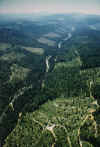
|

|
| Background | Hypotheses | Bibliography | Maps | Home |

|

|
| Background | Hypotheses | Bibliography | Maps | Home |
KRIS Web Background Pages: Riparian Areas
![]()
The KRIS Gualala database contains canopy cover information from habitat typing surveys provided by the California Department of Fish and Game (CA RA, In Review) and the Sotoyome Resource Conservation District. This information can be used to gauge stream health (see Habitat Typing background page). Canopy is measured with a densiometer. One problem with canopy information is that is does not indicate riparian over-story conditions, which effect microclimate and large wood recruitment potential (see Riparian Function and Protection Background page and Hypothesis #5).
 |
Clear cuts show in the photo at left of the North Fork Gualala River looking south along the San Andreas Fault. The clear cuts abut the 100-foot watercourse and lake protection zone (WLPZ). Because the USFS 90 meter riparian buffer has a one hectare resolution, tree size classes would be averaged with edge of the clear cut. Although these riparian zones afford shade, they are not sufficient to minimize airflow over streams (see Temperature Background page), and thus to fully protect cool water temperature regimes. Since redwoods may exceed 200 feet in height, if left to grow, harvests in the 100 to 200 foot band also deprive the stream of large wood. |

|
Rockpile Creek's 90 meter riparian buffer for the Middle Rockpile and Red
Rock Calwater planning watersheds are displayed at left. Natural grasslands
in eastern Rockpile Creek give rise to Non-Forest, Saplings and Small Trees.
However, the predominance of trees less than 20" in the Red Rock and
the western Middle Rockpile Calwaters are a result of very recent timber
harvest. Site potential in Rockpile Creek for conifer growth is high and
original riparian trees were over 17 feet in
diameter. Changes in the landscape between 1994 and 1998 based on Landsat
images, shows a similar pattern of riparian and inner gorge harvest, which
depletes potential large wood supply (see Hypothesis
#5).
|
![]()
References
California Resources Agency. In Review. Gualala River Watershed Synthesis. CA Dept. of Fish and Game, State Water Res. Control Bd., CA Dept. of Water Resources, CA Div. on Mines and Geology and CA Dept. of Forestry. Sacramento, CA. Draft released January 16, 2001.
Keithley, C. 1999. Evaluating Stream and Watershed Conditions in Northern California. Prepared for the California Department of Forestry, Fire and Resource Assessment Program. Sacramento, CA. 17 pp.
![]()
| www.krisweb.com |